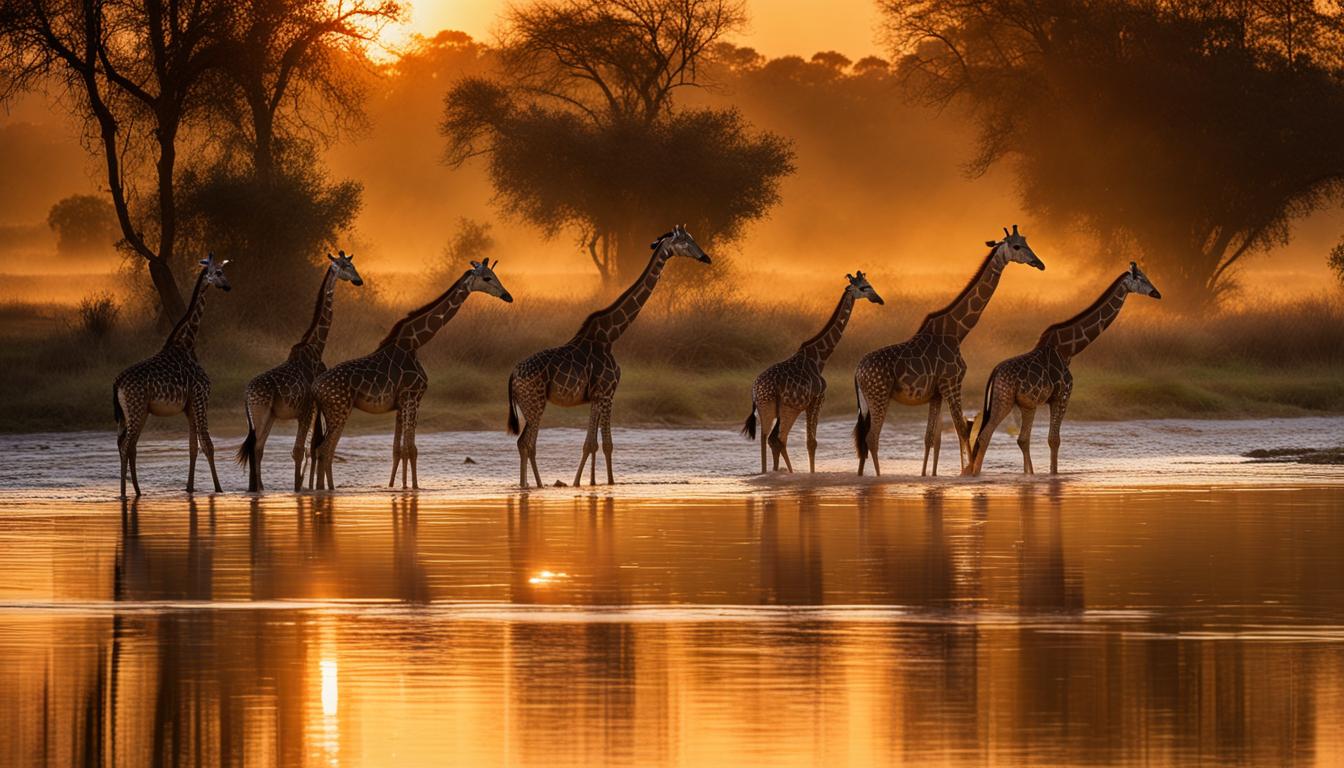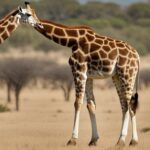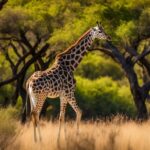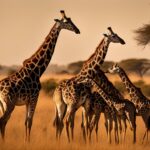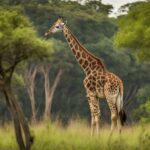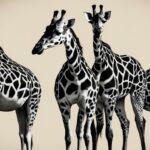If you’ve ever wondered about the fascinating migration patterns of giraffes in the African savannah, you’re in for a treat. Giraffe migration is a captivating phenomenon that sheds light on the intricate dynamics of African wildlife and their Savannah habitat. In this article, we’ll explore the reasons behind giraffes’ movements and how these journeys impact their survival strategies. So, buckle up and get ready to embark on a journey into the world of giraffe migration.
The Ecological Significance of Giraffe Migration
Giraffe migration plays a crucial role in the survival and adaptation of these majestic creatures. By embarking on long-distance travels, giraffes are able to access areas with abundant food resources. This allows them to optimize their foraging patterns and ensure their nutritional needs are met. Migration also helps giraffes avoid predation, as moving in herds dilutes the risk of individual members being targeted by predators. By understanding the ecological significance of giraffe migration, researchers can gain insights into the complex interplay between giraffes and their environment.
The availability of prey is a critical factor in the survival strategies of giraffes, and migration plays a crucial role in ensuring their access to prey. By moving to areas with higher prey availability, giraffes can sustain their energy levels and maintain a healthy population. This not only benefits the individual giraffes, but it also contributes to the overall health and stability of the ecosystem. Giraffe migration is therefore essential for maintaining the delicate balance of predator-prey relationships and the overall biodiversity of the African savannah.
Migration also allows giraffes to adapt to changing environmental conditions. The African savannah is characterized by seasonal variations, including changes in rainfall patterns and vegetation growth. By migrating to areas with more favorable conditions, such as areas with greener vegetation or reliable water sources, giraffes can ensure their survival and reproduction. This ability to respond to environmental changes through migration demonstrates the remarkable resilience and adaptability of these animals.
Giraffe Migration: A Delicate Balance
“Migration is an integral part of giraffe behavior, allowing them to navigate the challenges of their environment and secure their survival. By understanding the ecological significance of giraffe migration, we can better appreciate the intricate web of interactions that shape the African savannah ecosystem.” – Dr. Jane Griffin, Giraffe Conservation Society
In conclusion, the long-distance travel undertaken by giraffes during migration is not merely a random movement, but a purposeful and strategic behavior. It enables them to obtain prey, avoid predation, and adapt to changing environmental conditions. By studying and understanding the ecological significance of giraffe migration, we can enhance conservation efforts and protect the delicate balance of the African savannah ecosystem.
| Benefits of Giraffe Migration | Factors Influencing Giraffe Migration |
|---|---|
|
|
| Ecological Significance | |
|
|
Table: The benefits of giraffe migration and the factors influencing their movement decisions, as well as the ecological significance of their migration behavior.
Patterns and Routes of Giraffe Migration
Understanding the patterns and routes of giraffe migration is essential for gaining insights into their movement behavior and conservation needs. Studies have revealed that giraffes exhibit annual migration patterns, moving between different ranges in response to changes in resource availability and environmental conditions. While the exact routes of giraffe migration can vary depending on the population and habitat characteristics, tracking data and population surveys have helped researchers map out their migration routes and understand the factors influencing their movement decisions.
Giraffes undertake their annual migration to track the availability of resources such as food and water, as well as to avoid unfavorable environmental conditions. By moving between different areas, giraffes can access new foraging grounds and ensure their nutritional needs are met. Migration also plays a role in avoiding predation, as moving in herds dilutes the risk of individual giraffes being targeted by predators. These movements are not random; they follow specific routes that have evolved over time to optimize survival and reproductive success.
The annual migration patterns and migration routes of giraffes provide valuable information for conservation efforts. By understanding where and when giraffes move, researchers can identify critical migration corridors that need to be protected to ensure the continuity of their annual journeys. Preserving these migration routes is crucial for maintaining population connectivity, genetic diversity, and the overall health of giraffe populations. It also highlights the importance of habitat preservation and land management practices that prioritize the conservation of key areas along the migration routes.
| Annual Migration Patterns | Migration Routes |
|---|---|
| Giraffes exhibit annual migration patterns, moving between different ranges based on resource availability and environmental conditions. | The exact routes of giraffe migration vary depending on the specific population and habitat characteristics. |
| Giraffe migration allows them to track the availability of resources and avoid unfavorable environmental conditions. | Tracking data and population surveys have helped map out the migration routes of giraffes. |
| Moving in herds during migration helps giraffes avoid predation. | The identified migration routes inform conservation efforts to protect critical corridors. |
Factors Driving Giraffe Movements
Giraffe movements are influenced by various factors, including herd behavior and the dynamics of the African savannah ecosystem. Giraffes are social animals and often form loose herds, with individual members joining and leaving the group based on factors such as kinship and resource availability. This herd behavior plays a significant role in determining the movements of giraffes. By moving in groups, giraffes increase their collective awareness of potential threats and are better able to detect predators, increasing their chances of survival. Herd behavior also provides opportunities for social interactions, such as mating and sharing information about food sources and waterholes.
The African savannah ecosystem also plays a crucial role in driving giraffe movements. Giraffes rely on the availability of food resources, water sources, and suitable shelter to meet their basic survival needs. As the distribution of these resources varies across the savannah, giraffes must adapt their movements to access these essential elements. They can travel significant distances to reach areas with abundant food and water, especially during the dry season when resources may be scarce. By understanding the specific habitat requirements of giraffes and the factors that drive their movements, researchers can contribute to the effective management and conservation of giraffe populations.
“Giraffes are highly adaptable and display remarkable resilience in response to changing environmental conditions. Their movements reflect their ability to navigate through the diverse landscapes of the African savannah and find the necessary resources for their survival. By studying these movements, we can gain insights into the complex interplay between giraffes and their habitat, which is critical for conservation efforts.”
The dynamics of the African savannah ecosystem are constantly changing, driven by factors such as climate variations, land use changes, and human activities. These changes can influence the distribution and availability of resources, which in turn affect giraffe movements. For example, habitat fragmentation due to human development can disrupt migration routes, limiting the access of giraffes to essential resources and increasing the risk of population decline. By addressing these challenges and implementing conservation measures that promote the integrity of the savannah ecosystem, we can safeguard giraffe populations and their unique role in maintaining the biodiversity of the African landscape.
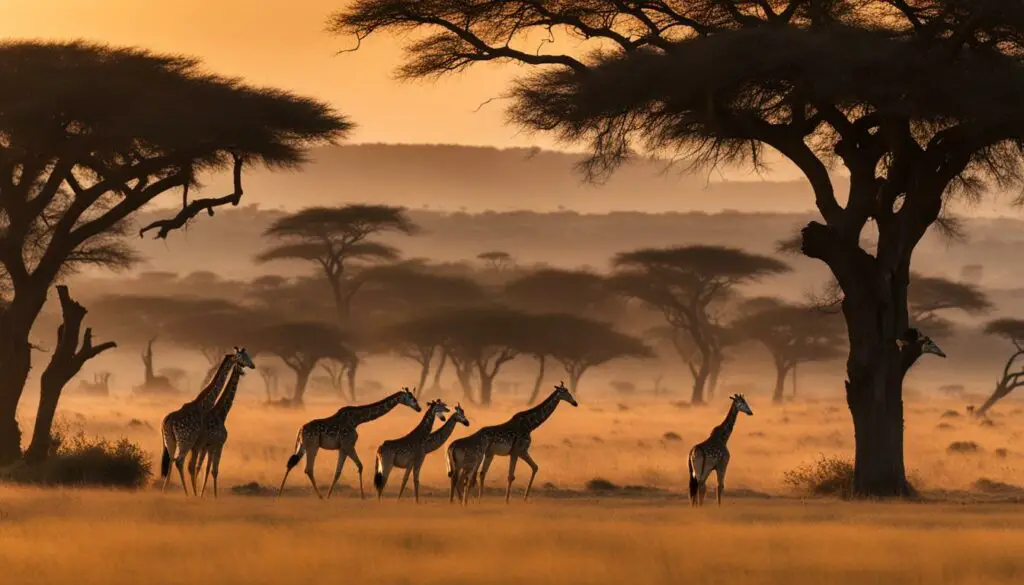
Conservation Implications of Giraffe Migration
Understanding the population dynamics and demographic effects of giraffe migration is essential for developing effective conservation strategies to ensure the long-term survival of these majestic creatures. Giraffes’ movement patterns have a significant impact on their populations and the overall health of their ecosystems. By studying the causes and consequences of giraffe migration, researchers can identify key factors influencing their movements and develop targeted interventions to address potential threats.
Giraffe migration plays a crucial role in maintaining genetic diversity within populations and promoting gene flow between different ranges. As giraffes migrate, they interact with other individuals, leading to the exchange of genetic material. This genetic mixing helps prevent inbreeding and maintains the adaptive potential of giraffes, allowing them to respond effectively to environmental changes. Therefore, preserving and protecting critical migration corridors is crucial for maintaining healthy and resilient giraffe populations.
Conservation strategies should also consider the impact of habitat loss and fragmentation on giraffe migration. Human activities such as urbanization, agriculture, and infrastructure development can disrupt migration routes and limit access to critical resources. By identifying and protecting key habitats, conservations can ensure the availability of food, water, and suitable breeding areas along migration routes, promoting successful movement and population growth.
Table: Conservation Strategies for Giraffe Migration
| Strategy | Description |
|---|---|
| Habitat Preservation | Protecting and preserving critical habitat areas, including migration corridors, feeding grounds, and breeding areas. |
| Land Management | Implementing sustainable land management practices that consider the needs of giraffes and their migration patterns. |
| Community Engagement | Involving local communities in conservation efforts to promote awareness, understanding, and support for giraffe migration. |
| Anti-Poaching Measures | Implementing strict anti-poaching measures to combat illegal hunting and protect giraffes from human-induced threats. |
| International Collaboration | Collaborating with international organizations, governments, and stakeholders to develop coordinated conservation strategies that transcend borders. |
By implementing these conservation strategies and considering the demographic effects of giraffe migration, we can ensure the long-term survival and well-being of giraffes in their natural habitats. Protecting the ecological integrity of the African savannah and preserving the intricate web of interactions between giraffes and their environment is crucial for maintaining the balance of this unique ecosystem.
Conclusion
Giraffe migration is a fascinating phenomenon that plays a crucial role in the survival and adaptation of these majestic creatures. By understanding the ecological significance of giraffe migration patterns and the factors driving their movements, researchers can develop effective conservation strategies to ensure the continued survival of giraffes and the rich biodiversity of the African savannah.
To protect giraffes and other African wildlife, it’s important to focus on preserving habitat connectivity and safeguarding critical migration corridors. By maintaining these pathways, we can enable giraffes to access areas with abundant food resources and avoid unfavorable environmental conditions.
Conservation efforts should also address threats such as habitat loss and poaching, which can disrupt giraffe migration patterns and have devastating effects on their populations. By implementing targeted conservation interventions, we can mitigate these risks and ensure the long-term well-being of giraffes.
Together, we have the power to make a difference. By supporting conservation organizations, advocating for wildlife protection, and raising awareness about the importance of giraffe migration, we can contribute to the preservation of these incredible creatures and the unique ecosystems they call home.
How Do Koalas Communicate and What Sounds Do They Make?
Koalas’ sounds and communication methods are predominantly non-verbal. They communicate through a combination of gestures, body language, and vocalizations. While they are not known for being particularly vocal, koalas produce various sounds including low grumbles, throaty barks, and even high-pitched squeaks. These sounds help them establish territory, attract mates, and communicate their emotional state to others.
FAQ
Do giraffes migrate?
Yes, giraffes do migrate. They exhibit a variety of movement strategies, including partial migration, where some individuals migrate while others remain resident.
What drives giraffe movements?
Giraffe movements are driven by factors such as resource distribution, predation risk, and social dynamics within giraffe populations.
What is the ecological significance of giraffe migration?
Giraffe migration plays a crucial role in optimizing their foraging patterns, accessing abundant food resources, and avoiding predation.
What are the patterns and routes of giraffe migration?
Giraffes exhibit annual migration patterns and their exact routes vary depending on the population and habitat characteristics.
What factors drive giraffe movements?
Giraffe movements are driven by factors such as herd behavior, the availability of food resources, water sources, and shelter.
What are the conservation implications of giraffe migration?
Understanding giraffe migration is crucial for developing effective conservation strategies and addressing threats such as habitat loss and poaching.

